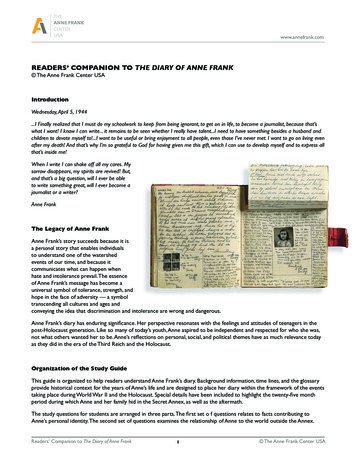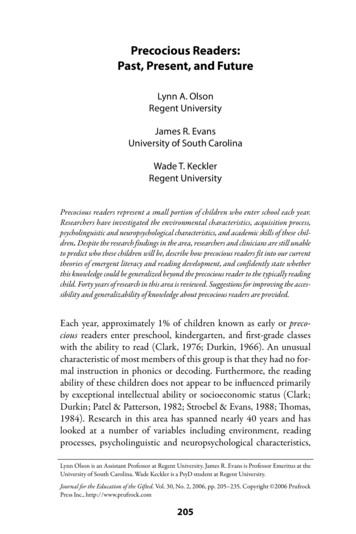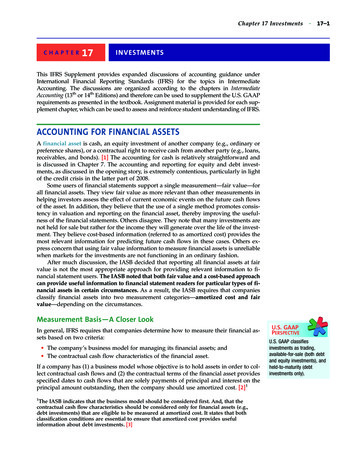
Transcription
www.annefrank.comREADERS’ COMPANION TO THE DIARY OF ANNE FRANK The Anne Frank Center USAIntroductionWednesday, April 5, 1944.I Finally realized that I must do my schoolwork to keep from being ignorant, to get on in life, to become a journalist, because that’swhat I want! I know I can write. it remains to be seen whether I really have talent.I need to have something besides a husband andchildren to devote myself to!.I want to be useful or bring enjoyment to all people, even those I’ve never met. I want to go on living evenafter my death! And that’s why I’m so grateful to God for having given me this gift, which I can use to develop myself and to express allthat’s inside me!When I write I can shake off all my cares. Mysorrow disappears, my spirits are revived! But,and that’s a big question, will I ever be ableto write something great, will I ever become ajournalist or a writer?Anne FrankThe Legacy of Anne FrankAnne Frank’s story succeeds because it isa personal story that enables individualsto understand one of the watershedevents of our time, and because itcommunicates what can happen whenhate and intolerance prevail. The essenceof Anne Frank’s message has become auniversal symbol of tolerance, strength, andhope in the face of adversity — a symboltranscending all cultures and ages andconveying the idea that discrimination and intolerance are wrong and dangerous.Anne Frank’s diary has enduring significance. Her perspective resonates with the feelings and attitudes of teenagers in thepost-Holocaust generation. Like so many of today’s youth, Anne aspired to be independent and respected for who she was,not what others wanted her to be. Anne’s reflections on personal, social, and political themes have as much relevance todayas they did in the era of the Third Reich and the Holocaust.Organization of the Study GuideThis guide is organized to help readers understand Anne Frank’s diary. Background information, time lines, and the glossaryprovide historical context for the years of Anne’s life and are designed to place her diary within the framework of the eventstaking place during World War II and the Holocaust. Special details have been included to highlight the twenty-five monthperiod during which Anne and her family hid in the Secret Annex, as well as the aftermath.The study questions for students are arranged in three parts. The first set o f questions relates to facts contributing toAnne’s personal identity. The second set of questions examines the relationship of Anne to the world outside the Annex.Readers’ Companion to The Diary of Anne Frank1 The Anne Frank Center USA
www.annefrank.comThe final set of questions considers the ongoing issues that Anne raised in her diary over fifty years ago. For additionaleducational materials, including teacher’s notes and activities, please contact the Anne Frank Center USA, 44 Park Place,New York, NY 10007, or e-mail us at education@annefrank.com.There is an additional set of questions for adults, designed for community groups, reading circles, and individuals.THE DIARYOn June 12, 1942, Anne Frank’s parents gave her a small red-and-white-plaid diary for her thirteenth birthday. More than fiftyyears later, this diary has become one of the best-known memoirs of the Holocaust.When Anne received her diary, she and her family were living in Amsterdam (The Netherlands) which was occupied by theGerman Army. By Anne’s thirteenth birthday she, like every other European Jew, was living in fear of the Nazis and theiranti-Jewish decrees. On July 6, 1942, her family was forced to go into hiding. Although they could take very few things withthem, Anne brought here diary to her new home, which she called the “Secret Annex.” For the two years that Anne lived inthe Annex, she wrote down her thoughts and feelings. She wrote about her life with the seven other people in hiding - herparents, her sister, the van Pels family (called van Daan by Anne), and Fritz Pfeffer (called Alfred Dussel by Anne), as well asthe war going on around her and her hopes for the future.As a result of a radio broadcast made the by Dutch government in exile asking people to save their wartime diaries forpublication after the war, Anne decided to rewrite here diary entries.On August 4, 1944, the Nazis raided the Secret Annex and arrested the residents. Anne’s entire diary - including the plaidbook, notebooks, and loose sheets of paper - remained behind in the Annex. Tragically, Anne Frank did not survive theHolocaust. Her father, Otto, the sole survivor among those who had hid in the Secret Annex, returned to Amsterdam afterthe war. Miep Gies, a woman who had risked her life to hide the Franks, gave Otto Anne’s diary, which she had hidden foralmost a year. As he read the entries, he was deeply moved by his daughter’s descriptions of life in the Annex and her feelingsabout her family and the other residents. He decided to publish the diary so that readers would learn about the effects ofthe Nazi dictatorship and its process of dehumanization.In the immediate aftermath of the war it was not easy for Otto to find a publisher for Anne’s work. He was told that no onewanted to read about the Holocaust. Finally a newspaper called Het Parool printed a story about Anne’s diary that capturedthe interest of Contact Publishers, a Dutch firm. In June 1947 Contact published 1,500 copies of the first Dutch edition ofthe diary. Within years the Contact edition was translated into German, French, and English. Today this version is available in67 languages and 31 million copies have been sold.The first edition omitted almost 30 percent of Anne’s original diary. Otto Frank quite deliberately excluded sections whereAnne expressed negative feelings about her mother and others in the Annex, believing that Anne wouldn’t have liked suchviews made public. In addition, Contact was a conservative publishing house and was uncomfortable printing Anne’s entriesconcerning her burgeoning sexuality.Otto Frank gave the diary to the Netherlands Institute for Was Documentation (Rijksinstituue voor Oorlogsdocumentatie(RIOD), which received it after his death in 1980. Scholars associated with RIOD were particularly interested in refutingthe accusations by neo- Nazi Holocaust deniers that the diary was a hoax. To establish its validity, RIOD performed testson the paper, ink, and glue used in the diary, proving that it was written during the 1940’s. Also, tests were performed onAnne’s handwriting, comparing samples from the diary with her other writings, which included letters with dated stampcancellations.In 1986 RIOD published The Critical Edition of Anne’s diary. This edition is often used as the scholarly, research-orientedversion of the diary and contains all of the entries that Otto Frank and the Contact Publishers had removed from theoriginal 1947 edition. Entries that Anne rewrote after March 1944 are placed next to the original entries to show heredevelopment as a writer. The 1986 edition also includes transcripts of the tests verifying the authenticity of the diary, as wellas some of the short stories and sketches written in the annex.In 1995 Doubleday published The Definitive Edition , on the fiftieth anniversary of Anne Frank’s death. This edition, based onReaders’ Companion to The Diary of Anne Frank2 The Anne Frank Center USA
www.annefrank.coma new English translation of the original Dutch text, contains entries that both Otto Frank and Contact Publishers omittedfrom the 1947 edition. By restoring sections from the original diary, the 1995 edition makes readers aware of the complexityand sensitivity of Anne Frank, an adolescent struggling to find her own identity during turbulent and uncertain times.THE FRANK FAMILYAnne Frank, born on June 12, 1929, was the second daughter of Otto and Edith Frank, both from respected GermanJewish families engaged in commerce for many generations. Otto Frank could trace his heritage in Frankfurt back tothe seventeenth century, and Edith Hollander Frank came from a prominentAachen family. Anne and her older sister, Margot, were raised in Germany in anatmosphere of tolerance; the Franks had friends of many faiths and nationalities.Otto Frank served honorably as an officer in the German Army during WorldWar I.However, the circumstances of the early 1930s dramatically altered the situationfor the Frank family. The National Socialist German Workers’ Party, the Nazis,ascended to power in 1933 and launched a campaign to rid Germany of itsJewish citizens. The Nazis blamed the Jews for the economic, political, and socialhardships that had befallen Germany, thought less than 1 percent of the Germanpopulation was Jewish. Many German Jews felt this to be a passing phenomenon,while others, including the Frank family, decided to leave Germany altogether.The Franks decided to move to Amsterdam, the Netherlands, which had beenknown for centuries as a safe haven for religious minorities.In the summer of 1933 Otto Frank left Frankfurt for Amsterdam to set up abranch of his brother’s company called the Dutch Opekta Company, whichproduced pectin, an ingredient used in making jam. Edith, with her daughtersMargot and Anne, went to Aachen to stay wither her family, the Hollanders, untilOtto Frank established the business and found a new home for his family.By the mid-1930s the Franks were settling into a normal routine in theirapartment at 37 Merwedeplein: the girls were attending school; the family tookvacations at the beach; and their circle of Jewish and non-Jewish friends grew. In 1938Otto expanded his business, going into partnership with the spice merchant Hermannvan Pels, also a Jewish refugee from Nazi Germany.Unfortunately, the Frank’s belief that Amsterdam offered them a safe haven from Nazismwas shattered when, in May 1940, Germany invaded the Netherlands and the Frankswere once again forced to live under Nazi rule. In the first years of the occupation, Anneand Margot continued to socialize with their friends and attend school. But the Naziadministration, in conjunction with the Dutch Nazi Party and civil service, began issuinganti-Jewish decrees. As Anne wrote on June 20, 1942:Our freedom was severely restricted by a series of anti-Jewish decrees: Jews were required towear a yellow star; Jews were required to turn in their bicycles; Jews were forbidden to usestreetcars; jews were forbidden to ride in cars, even their own; Jews were required to do theirshopping between 3 and 5 p.m.; Jews were required to frequent only Jewish-owned barbershopsand beauty parlors; Jews were forbidden to be out on the streets between 8 p.m. and 6 a.m.;.Jews were forbidden to visit Christians in their homes; Jews were required to attend Jewishschools, etc.Fortunately, Otto Frank, in anticipation of this decree, had already turned his businessover to his non-Jewish colleagues Victor Kugler and Johannes Kleiman.Readers’ Companion to The Diary of Anne Frank3 The Anne Frank Center USA
www.annefrank.comBy 1942 mass arrests of Jews and mandatory service in German work camps were becoming routine. Fearful for theirlives, the Frank family began to prepare to go into hiding. They already had a place in mind - an annex of rooms above OttoFrank’s office at 263 Prinsengracht in Amsterdam. In addition, people on the office staff at the Dutch Opekta Companyhad agreed to help them. Besides Kugler and Kleiman, there were Miep and Jan Gies, Bep Voskuijl, and Bep’s father - allconsidered to be trustworthy. These friends and employees not only agreed to keep the business operating in theiremployer’s absence; they agreed to risk their lives to help the Frank family survive. Mr. Frank also made arrangements for hisbusiness partner, Hermann van Pels, along with his wife, Auguste, and their son, Peter, to share the Prinsengracht hideaway.While these preparations were secretly under way, Anne celebrated her thirteenth birthday on June 12, 1942. On July 5,1942, her sister Margot, received a call-up notice to be deported to a “work camp.” Three days later Anne remembered:Margot told me that the call-up was not for Father, but for her. At his second shock, I began to cry. Margot is sixteen - apparently theywant to send girls her age away on their own. But thank goodness she won’t be going; Mother had said so herself, which must be whatFather had meant when he talked to me about our going into hiding. Hiding.where would we hide? In the city? In the country? In ahouse? In a shack? When, where, how.? These were questions I wasn’t allowed to ask.Even though the hiding place was not yet ready, the Frank family realized that they had to move right away. They hurriedlypacked their belongings and left notes implying that they had left the country. On the evening of July 6, they moved intotheir hiding place. A week later, on July 13, the van Pels family joined the Franks. On November 16, 1942, the seven residentsof the Secret Annex were joined by its eighth and final resident, Fritz Pfeffer. For two years the Franks were part of anextended family in the Annex, sharing a confined space and living under constant dread of detection and arrest by the Nazisand their Dutch sympathizers.Since the Annex was above a business, and buildings on either side wereoccupied, the eight residents had to be extremely quiet so they wouldn’tbe discovered. They also lived in fear of break-ins, which became commonduring the occupation. Their only link to the outside world was throughtheir helpers and radio broadcasts from the BBC. For Anne, the normalstresses of changing from a child to a teenager to a young woman wereheightened by the confined space. She recorded all of this in her diary. Partof her entry for Friday, December 24, 1943, reads:Whenever someone comes in from outside, with the wind in their clothes and thecold on their cheeks, I feel like burying my head under the blankets to keep fromthinking, “When will we be allowed to breather fresh air again?”.I long to ride abike, dance, whistle, look at the world, feel young and know that I’m free, and yet Ican’t let it show.At approximately 10 a.m., August 1944, the Frank family’s greatest fear wasrealized. A Nazi policeman and several Dutch collaborators appeared at263 Prinsengracht, having received an anonymous phone call about Jews hiding there, and charged straight for the bookcaseleading to the Secret Annex. Karl Josef Silberbauer, an Austrian Nazi, forced the residents to turn over all valuables. Whenhe found out that Otto Frank had been a lieutenant in the German Army during World War I, he treated the family with alittle more respect. The residents were taken from the house, forced onto a covered truck, taken to the Central Office forJewish Emigration, and then to Weteringschans Prison. Two of the helpers,Victor Kugler and Johannes Kleiman, were alsoimprisoned, for their role in hiding the prisoners. Miep Gies and Bep Voskuijl were not arrested, although Miep was broughtin for questioning by the police.The Nazi and Dutch police left the Secret Annex a mess. They had emptied Otto Frank’s briefcase, which held Anne’s diary,onto the floor to fill it with valuables. The floor was strewn with clothing, paperwork, and other belongings of those whohad been hiding there. Miep and Bep returned to the Annex and found Anne’s diary and family photo album in the clutter.Miep brought the diary downstairs, where she kept it hidden in her desk. About a week later the Nazis emptied out theentire Annex.On August 8, 1944, after a brief stay in Weteringschans Prison, the residents of the Secret Annex were moved to Westerborktransit camp. They remained there for nearly a month, until September 3, when they were transported to the AuschwitzReaders’ Companion to The Diary of Anne Frank4 The Anne Frank Center USA
www.annefrank.comdeath camp in Poland. Ironically, it was the last Auschwitz-boundtransport ever to leave Westerbork.Upon arrival at Auschwitz, the men were separated from thewomen. Hermann van Pels was the first to die. He was murderedin the gas chambers on September 6. Fritz Pfeffer was movedto Neuengamme concentration camp in Germany (probably viaSachsenhausen or Buchenwald), where he died on December 20,1944.In October 1944 Anne, Margot, and Mrs.Van Pels were transportedto the Bergen-Belsen concentration camp in Germany. Edith Frankremained in the women’s subcamp at Auschwitz-Birkenau, whereshe died on January 6, 1945. Thousands died from planned starvationand epidemic at Bergen-Belsen, which was without food, heat,medicine, or elementary sanitary conditions. Anne and Margot,already debilitated, contracted typhus and grew ever sicker. Both Ane, fifteen years old, and Margot, nineteen years old, diedin March, 1945.Mrs.Van Pels was transported to Buchenwald and finally to the Theresienstadt camp in Czechoslovakia, where she diedin the Spring of 1945. Her son Peter was sent from Auschwitz on a death march. He survived the march but died inMauthausen in Austria, on May 5, 1945, a few days before the camp was liberated.Otto Frank, the only resident of the annex to survive the Holocaust, returned to Amsterdam after the war. He was totallyunaware of the deaths of his daughters. He searched all possible leads to locate them before learning from a woman whohad been with the sisters in the barracks at Bergen-Belsen that they had died. Otto also discovered that his wife, the vanPels family, and Fritz Pfeffer had all died in the Holocaust.Fortunately, all of the helpers managed to survive the war. Johannes Kleiman and Victor Kugler had been sent to theAmersfoort police transit camp, and sentenced, without trial, to forced labor. Kleiman fell ill during this time and was senthome; he lived in Amsterdam until his death in 1959. Kugler escaped during an air raid and made his way back to Amsterdam;he emigrated to Canada in 1955 and died there in 1989. Bep Voskuijl died in Amsterdam on May 6, 1983. Miep and Jan Giesremained in Amsterdam, raising a son. Jan died on January 26, 1993. Miep continues to live in Amsterdam, where she is activein educating people about the Holocaust and its lessons for today’s society.Otto Frank found it difficult to settle permanently in Amsterdam with its constant reminders of his lost family. He and hissecond wife, Elfriede Geiringer, also an Auschwitz survivor, moved to Basel, Switzerland, in 1953, Otto Frank died on August19, 1980, at the age of ninety-one.RESTORED DIARY ENTRIESEntries with restored material in the Definitive Edition of Anne Frank:The Diary of A Young Girl include:HISTORICALSunday, June 14, 1942 Tuesday, February 8, 1944Monday, June 15, 1942 Tuesday, February 15, 1944Wednesday, July 1, 1942 Thursday, February 17, 1944Sunday, July 12, 1942 Sunday, February 20, 1944Friday, August 21, 1942 Thursday, March 2, 1944Wednesday, September 2, 1942 Wednesday, March 8, 1944Thursday, October 1, 1942 Friday, March 10, 1944Saturday, October 3, 1942 Saturday, March 11, 1944Readers’ Companion to The Diary of Anne Frank5 The Anne Frank Center USA
www.annefrank.comWednesday, October 7, 1942 Sunday, March 12, 1944Wednesday, October 14, 1942 Saturday, March 18, 1944Monday, November 2, 1942 Friday, March 24, 1944Thursday, November 5, 1942 Saturday, March 25, 1944Saturday, May 1, 1943 Thursday, April 27, 1944Sunday, May 2, 1943 Tuesday, May 9, 1944Saturday, August 7, 1943 Thursday, May 11, 1944Tuesday, August 10, 1043 Thursday, May 25, 1944Thursday, December 30, 1943 Friday, June 2, 1944Wednesday, January 19, 1944 Tuesday, June 6, 1944Sunday, January 30, 1944 Friday, June 30, 1944CONTEXT OF THE DIARY OF ANNE FRANKAnne Frank’s life (1929-45) spanned the most critical years in the history of the Third Reich and the Holocaust. Born inthe waning years of the democratic Weimar Republic, Anne Frank was only four years old when Hitler and the Nazi Partyascended to power. The Weimar Republic, established after Germany’s defeat in World War I, had failed to garner widespreadsupport. Unemployment, inflation, labor unrest, and rising violence in the streets were all associated in the popular mindwith the inability and inefficiency of the Weimar politicians. Extremist parties, which put forth promises of a better future,gained popularity.The National Socialist German Workers’ (Nazi) Party, founded in 1919, was among those benefitting from the unsettledpolitical and economic times. Its programs promised to restore honor and greatness to Germany. To accomplish thesegoals, the Nazis advocated a Germany free of Jews and other groups who endangered the destiny of the Third Reich. In1933 Adolf Hitler, the leader of the Nazi Party, was appointed Chancellor of Germany. As soon as the Nazis were in power,Jews, a very small minority in Germany, were subjected to arbitrary arrests and attacks in the streets. Humiliation of Jewsin their synagogues, an economic boycott of Jewish businesses in April 1933, and the firing of Jewish civil servants furtherdemonstrated the hostile environment.Jews who stayed in Germany witnessed a gradual progression of anti-Semitic measures. While there was sporadic terroragainst Jews in 1933, by 1935 the Nuremberg Laws determined who the Jews were, legalizing their inferiority and theirstateless status. Hundreds of pieces of anti-Semitic legislation became law in the middle and late 1930’s, segregating Jewsfrom all aspects of German life.In 1938, as the Third Reich expanded to incorporate Austria and parts of Czechoslovakia, the Nazis escalated their campaignagainst the Jews. A world conference at Evian, France, with representatives from thirty-two nations, failed to offer anyhelp or haven for the Jews of Germany and Austria. On November 9 and 10, 1938, a nationwide pogrom, later known asKristallnacht (Night of the Broken Glass) resulted in massive destruction of Jewish property and synagogues. Thirty thousandJewish men and boys were arrested and deported to concentration camps.On the eve of the war Hitler ordered the killing of institutionalized handicapped patients, calling them “useless eaters.”The program, named T-4, transferred the victims to six institutions in Germany and Austria, some equipped with special gaschambers.WORLD WAR IIThe German surprise invasion of Poland in September 1939 began World War II and greatly expanded the Third Reich.Countries in Easter and Western Europe were rapidly invaded. By 1940 Denmark, Norway, Belgium, Luxembourg, andFrance were controlled by the Nazis, who established ghettos, transit cams, and forced-labor camps, in addition to theconcentration camps. The Nazis rounded up and deported massive numbers of prisoners, putting them into hundreds ofnew camps filled with political opponents, resistance fighters, Jews, Gypsies, homosexuals, Jehovah’s Witnesses, and othervictims of the Nazi policies.Readers’ Companion to The Diary of Anne Frank6 The Anne Frank Center USA
www.annefrank.comThe German invasion and conquest of the Netherlands began on May 10, 1940, and ended on May 14, after the destructionof Rotterdam. Throughout most of Nazi-occupied Europe the Nazis now expanded their program to make Europe judenrein,or “Jew-free,” an idea that had been introduced in the 1930’s. However, during the war years anti-Semitic legislation andphysical violence against Jews intensified. In the Netherlands, they were registered, isolated, and removed from public life;their businesses were Aryanized within eighteen months.The year 1941 marked a turning point in the course of the war. The German Army invaded the Soviet Union, therebyincreasing by 3 million the number of Jews under their domination. Mobile killing squads called Einsatzgruppen followed theGerman army throughout the conquered territories, where they rounded up people, forced them to undress in front ofmass graves, and shot them in masses.In the summer and fall of 1941, the Nazi hierarchy decided to move to the next stage of their policy regarding Jews. This ledto the period of systematic mass murder in death camps, beginning in late 1941, which the Nazis referred to in their codewords “The Final Solution of the Jewish Question.” The six killing sites, close to rail lines in various areas of Poland, were atBelzec, Sobibor, Treblinka, Chelmo, Majdaned, and Auschwitz-Birkenau.The purpose of the death camps was mainly to kill Jews, but there were many other victims as well. Majdanek andAuschwitz-Birkenau were special cases, having both labor facilities and killing centers. Other camps such as Bergen-Belsenbecame places of death for thousands of victims through starvation and disease. In addition to these camps, the Naziscontinued to expand the slave-labor-camp system to thousands throughout the Third Reich. Here prisoners were literallyworked until they were no longer useful to the Nazis, then put to death.There were, however, people throughout the Third Reich who found the courage to help others. Like the Franks’ helpers,many risked their lives to hide Jews and others from the Nazis. Organized resistance to the Nazis was punishable by death,but despite this, there were armed revolts by Jews in the death camps of Treblinka, Sobibor, and Auschwitz. The uprising inthe Warsaw Ghetto held off German soldiers from April to May 1943.THE HOLOCAUST IN THE NETHERLANDSIn the Netherlands the first mass arrests of Jews began in February 1941. The Nazis began Rassen, or roundups: Jewish menand boys were grabbed from their homes, beaten, and deported. In June 1941 the Dutch people of Amsterdam protested ina two-day strike which Nazi troops quickly put down.In the first months that the Frank family lived in the Secret Annex, the deathcamps in Poland were operating at full capacity. Anne sensed the dangerfor Jews, although she was not aware of the full magnitude of mass murderoccurring hundreds of miles to the east. As she remarked in her diary onNovember 19, 1942:In the evening when it’s dark, I often see long lines of good, innocent peopleaccompanied by crying children, walking on and on, ordered about by a handful ofmen who bully and beat them until they nearly drop. No one is spared.The sick, theelderly, children, babies, and pregnant women - all are marched to their death.Listening to the news of the war on the radio was extremely important to theinhabitants of the Annex. Only Germany’ defeat would end the mass killing ofJews and other innocent victims. During 1943 and 1944, reports of Germany’smilitary reversals provided the Annex residents with hope for the future.News of events such as the halting of German troops in the Soviet Union inFebruary 1943, as well as the Allied invasion of Sicily and Italy beginning thefollowing July, prompted Anne to write optimistically about the approachingend of the war. Nevertheless, she was saddened to realize that the decliningmilitary situation for Germany did not mitigate the war against the Jews. Sheespecially despaired over the massive arrests and deportation of HungarianReaders’ Companion to The Diary of Anne Frank7 The Anne Frank Center USA
www.annefrank.comJews in May and June 1944. Although D Day operations elated Anne and theothers in the Annex, the war still dragged on, leaving them wondering whenit would ever end.On July 15, 1944, Anne expressed her sense of foreboding:It’s utterly impossible for me to build my life on a foundation of chaos, sufferingand death. I see the world being slowly transformed into a wilderness, I hearthe approaching thunder that, one day, will destroy us too. I feel the suffering ofmillions. And yet, when I look up at the sky, I somehow feel that everything willchange for the better, that this cruelty too shall end, that peace and tranquility willreturn once more. In the meantime, I must hold on to my ideals. Perhaps the daywill come when I’ll be able to realize them!THE END OF THE WARThe arrests of the residents of the Secret Annex on August 4, 1944, and their subsequent deportation from Westerborkto Auschwitz took place during the months that the Germans were facing defeat. Soviet troops had already entered theMajdanek death camp in Lublin and publicized the horrors they found.As the Allies reached the occupied countries, the Nazis began to cover up the evidence of genocide and forced prisonersto march on foot toward central Germany to prevent their liberation. Many inmates died or were killed if they could notwalk. During the final days, in the spring of 1945, conditions at the remaining camps were so inhumane that many moredied. Concentration camps such as Bergen-Belsen became a death trap for thousands, including Anne and Margot Frank. OnNovember 24, 1944, SS leader Heinrich Himmler ordered the destruction of Auschwitz’s crematoria and the removal of asmany prisoners as possible as the Russians approached the camp.The loss of Jewish lives in the Netherlands alone illustrates the magnitude of mass murder that occurred during theHolocaust. By July 1944 the country was virtually judenrein. In 1940 approximately 140,000 Jews had lived in the Netherlandsduring the Nazi occupation; 106,000 Jews there, three out of every four, perished.By May 1945 Nazi Germany collapsed and the war was over in Europe. The SS guards fled the concentration, forced-labor,and death camps. The camps were liberated and the world saw the evidence of the Holocaust.THE AFTERMATHAfter the war the world tried to grapple with what had happened and to work to prevent its recurrence. As Otto Frankprepared Anne’s diary for publication, the International Military Tribunal at Nuremberg sought to prosecute some of theNazi leaders and to document their crimes as a warning for the future. Judges from the Allied Powers, including GreatBritain, France, the United States, and the Soviet Union, heard evidence against twenty-two Nazi criminals for “crimesagainst peace” and “war crimes,” which violated the laws and customs of warfare, and “crimes against humanity.” Fourteenhigh-ranking Nazis were sentenced to death; others were sent to prison. Most of those prosecuted admitted that theyw
Reader’ Coanion to The Diary of Anne Frank The Anne Frank Center USA a new English translation of the original Dutch text, contains entries that both Otto Frank and Contact Publishers omitted from the 1947 edition. By restoring sections from the original diary, t











